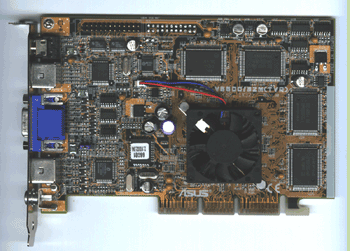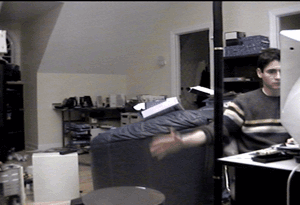
Original Link: https://www.anandtech.com/show/459
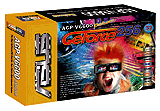 As
few as two years ago, if you had asked any of us at AnandTech which company
was dominating the market for video card products, not a single one of us would
have answered ASUS. Sure, for motherboards ASUS has always been a leader of
the pack, creating great products with unsurpassed quality, but as far as video
cards were concerned, ASUS was a non-factor It was not until ASUS's break into
the video card market with the TNT based V3400 did the company begin to capture
a strong hold on the graphics market.
As
few as two years ago, if you had asked any of us at AnandTech which company
was dominating the market for video card products, not a single one of us would
have answered ASUS. Sure, for motherboards ASUS has always been a leader of
the pack, creating great products with unsurpassed quality, but as far as video
cards were concerned, ASUS was a non-factor It was not until ASUS's break into
the video card market with the TNT based V3400 did the company begin to capture
a strong hold on the graphics market.
The idea does not seem novel to us now, but ASUS decision to expand from being a motherboard producer to a video card powerhouse was considered quite revolutionary. On the other hand, ASUS saw it as a David versus Goliath situation: it could use its motherboard foundation to produce some of the greatest video cards on the market. ASUS seized the opportunity to extend their market to video cards as well as to continue their almost renowned quality. ASUS's dream of domination originally became a reality with the V3400. This dream, however, has continued throughout the years, a fact which may be seen with their most recent GeForce addition: the V6600 Deluxe, a card quite worthy of the V series name.
Specifications, courtesy
of ASUS:
Key Benefits |
|
Powered by the World's First Graphics Processing Unit (GPU) - NVIDIA GeForce 256 |
|
Built-in
32MB Frame Buffer (SGRAM)- Provides more resolutions and color depths
|
|
Smart Doctor Technologies- Smart cooling, dynamic overclocking, overheat protection, fan speed monitoring, AGP power level monitoring |
|
VR 3D Glasses- D3D games and stereo picture viewing |
|
ASUS LIVE Capture Driver- 704x480 real time 30 fps video capture |
|
Large Screen TV-Out (800x600)- S-Video and Composite connectors |
|
Video-In
Support- Video capture, video editing, video conference...
|
|
ASUS
DVD/SW Player Bundled- DVD, VCD, MP3, SVCD... playback
|
|
Unlead
VideoStudio 3.0 + MPEG-II Color Encoder Bundled- Video editing, MPEG/II
encoding and real time capture
|
|
3D
Games Bundled- DRAKAN (full version), ROLLCAGE (full version), and 12
other game titles
|
|
Other Key Benefits of AGP-V6600 Series- QuadPipe Rendering, Transforming & Lighting, and AGP 4X with Fast Writes, ect... |
- Quad Engine Architecture
Four independent pipelined engines
15M triangles/second
Sustained DMA, transform/clip/light, setup, and render rate
>70% of the chip active at all times
Up to 6 triangles "in flight" at a time (typically 1-3)
Very low latency between engines - ASUS Smart Doctor
Technologies
Provides the best system safety
SmartCooling Technology
Dynamic overclocking
Over-heat protection
Fan RPM monitoring
AGP power level Monitoring - AGP-V6600 Takes Interactive
PC Graphics to More Realistic and Detailed Levels
Full frame rate DVD to 1080 resolution
Full precision subpixel accuracy to 1/16 pixel
5 horizontal, 3 vertical taps
8:1 up/down scaling
Independent hue, saturation and brightness controls in hardware - Optimized for the
latest DirectX 7 and OpenGL features
Transform and lighting (T&L)
Cube environment mapping
Vertex blending
Protective textures
Texture compression
- Superior 2D Performance
256-bit 2D rendering pipeline
4 pixels per clock on all scaled and indexed image operations
1 GB/s CPU-to-GPU memory via AGP 4X with Fast Writes - AGP 4X with Fast Write
Enables CPU to send data directly to GPU
System memory bus free to perform other functions
Balanced design increases overall system performance - High Quality Video
Playback: DVD Acceleration
Full frame rate DVD to 1080i resolution
Full precision subpixel accuracy to 1/16 pixel - High Quality Video
Playback: Video Overlay
5 horizontal, 3 vertical taps
8:1 up/down scaling
Independent hue, saturation, and brightness controls in hardware - 3D Stereoscopic Features
Turns D3D games into virtual reality gaming world
VR Viewer software bundled for 3D pictures viewing - Video Features for
Video-in
Complete S-VHS and Composite video-input ports support
ASUS Live driver supports 704x480 real time video capture (for Windows 95/98 only) - Video Features for
TV-out
Digital video output by integrated NTSC/PAL encoders
Complete S-VHS and Composite video-input ports support
High quality TV-out supports 800x600 resolutions
|
Max Refresh Table |
||
|
Resolution |
Color Depth (BITS) |
Max Refresh Rate (Hz) |
|
640 x 480 |
8/16/32 |
240/240/240 |
|
800 x 600 |
8/16/32 |
240/240/240 |
|
1024 x 768 |
8/16/32 |
240/240/200 |
|
1152 x 864 |
8/16/32 |
200/200/170 |
|
1280 x 960 |
8/16/32 |
170/170/150 |
|
1280 x 1024 |
8/16/32 |
170/170/170 |
|
1600 x 900 |
8/16/32 |
150/150/120 |
|
1600 x 1200 |
8/16/32 |
120/120/100 |
|
1920 x 1080 |
8/16/32 |
100/100/85 |
|
1920 x 1200 |
8/16/32 |
100/100/85 |
|
1920 x 1440 |
8/16/32 |
85/85/75 |
|
2048 x 1536 |
8/16/32 |
75/75/60 |
Now that the GeForce processor
has been on the market for some time now, companies have been able to switch
from using NVIDIA's reference deign to a design which makes more sense for the
manufacturer. This is the path that ASUS chose to take, switching from the reference
design found in the V6600 SDRAM to the proprietary design found in the V6600
Deluxe. This change in design allowed for many improvements to be made the board,
providing a more powerful and more advanced card.
As far as SDR GeForce cards out there, we have never seen one like the V6600 Deluxe. Beginning with the 32 MB of 5 ns SGRAM chips and going down all the way to hardware monitoring and S-Video connectors, ASUS has created a card that will make not only hard-core gamers but also home video editors rush to their nearest retailer.
As stated above, the card includes 5 Ns (200 MHz) SGRAM chips arranged in eight spots on the card (four on front, four on back). This card is the first that we have seen to include such powerful RAM chips on a standard SDR board, and the choice to do so was a wise one for ASUS. By including 5 Ns SGRAM standard on the board ASUS clocked the memory 166 MHz stock (as requested by NVIDIA), and left high overclocking potential.
In addition to the high quality memory standard, ASUS also left the processor clock at the standard speed of 120 MHz, once again at the request of NVIDIA (the original design had it running at 150 MHz stock). Any heat that results from the GPU is quickly dissipated by the included hardware monitoring fan. Spinning at 5000 RPM and stuck on the GPU with a precisely applied layer of thermal grease, the processor was cooled by a very efficient design. In fact, as written in the Overclocking section, this setup allowed us to push the GeForce core to places never traveled to by a GeForce before.
Now comes the real icing on the cake: the S-Video in and out features as well as composite out. The S-Video out features of the V6600 Deluxe are controlled by one of the best video out controllers available: the Chrontel 7005. This is essentially the same chip that received such high ratings in our Picture This: TV-Output Comparison with a few additional features, such as enhanced text sharpness. This chip provides the V6600 Deluxe with a very clear and crisp display output via the included S-Video cable. Even using the composite output, image quality is nothing to be ashamed of, even if it is still on an older television. The S-Video in functions of the V6600 Deluxe are controlled by the Philips SAA7113A video input processor, a chip that we have not yet seen. The quality of this chip is described in the following section. One thing to be noted is the lack of a composite in connection. While all new video devices come with S-Video standard, the V6600 Deluxe leaves users of older technology in the dust and clinging to their Voodoo 3500 cards.
Finally, there lies yet
another feature of the card that gives the V6600 Deluxe a bit of additional
oomph; oomph which is provided by the built-in VR 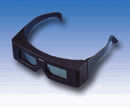 plug
and included glasses. Coming out from what appears to be a headphone jack on
the video card lies the ability to see OpenGL and D3D games in 3D mode. Plugging
in the included glasses causes the polarized lenses of the glasses to turn on
and off at a quick rate, almost like you are seeing everything with flicker.
This technology, which has been around the gaming world for quite some time
now but just recently found its way into the mainstream PC game market, works
by fooling the eye into seeing depth. This is accomplished by rendering alternating
frames in a game during each refresh cycle of the monitor. The glasses work
in conjunction with this technology in order to match each frame to a separate
eye. This is done using a polarizing effect. When electricity is passed through
a thin layer of a semitransparent polarized substance that is sandwiched between
two pieces of glass, the polarized part becomes darker. This lightening and
darkening of the glass occurs in synchronization with the monitor refresh to
allow only one eye to see each frame. For example, frame 1 is rendered for the
left eye a bit to the left side of the screen and viewed through the transparent
left lens. Then, the second frame in the game placed on the right side of the
screen while the left lens of the glasses go dark. This works in the same way
that normal depth perception is formed, as your eyes (which are set apart) do
this naturally. To the onlooker without glasses, the game in question looks
like two pictures overlapped on one another. To the person viewing through the
glasses, the effect is 3D: looking almost like images and text are jumping out
at you.
plug
and included glasses. Coming out from what appears to be a headphone jack on
the video card lies the ability to see OpenGL and D3D games in 3D mode. Plugging
in the included glasses causes the polarized lenses of the glasses to turn on
and off at a quick rate, almost like you are seeing everything with flicker.
This technology, which has been around the gaming world for quite some time
now but just recently found its way into the mainstream PC game market, works
by fooling the eye into seeing depth. This is accomplished by rendering alternating
frames in a game during each refresh cycle of the monitor. The glasses work
in conjunction with this technology in order to match each frame to a separate
eye. This is done using a polarizing effect. When electricity is passed through
a thin layer of a semitransparent polarized substance that is sandwiched between
two pieces of glass, the polarized part becomes darker. This lightening and
darkening of the glass occurs in synchronization with the monitor refresh to
allow only one eye to see each frame. For example, frame 1 is rendered for the
left eye a bit to the left side of the screen and viewed through the transparent
left lens. Then, the second frame in the game placed on the right side of the
screen while the left lens of the glasses go dark. This works in the same way
that normal depth perception is formed, as your eyes (which are set apart) do
this naturally. To the onlooker without glasses, the game in question looks
like two pictures overlapped on one another. To the person viewing through the
glasses, the effect is 3D: looking almost like images and text are jumping out
at you.
 Not a new weapon, just VR without the glasses. |
There are three main downsides to these glasses. First, and most severely, are the headaches that occasionally come when playing in D3D VR or OpenGL VR for extended periods of time. While the maximum refresh rate is 160 Hz (as long as your monitor can support it), some people still experience problems with extended game play due to the constant flicker and trickery of the brain. Secondly, the glasses do not turn off as long as they are plugged in. This means that as long as you do not want a pair of not so stylish glasses flickering on your desk, you actually have to go to the back of your computer and unplug the device. Would an on/off switch be too much to ask? Finally is the gimmick factor. While the glasses are super cool for about the first week of play, they will not help you play better or last longer. The glasses are a fun thing to show visiting friends or to play with when you are bored, but there is no real advantage to using them (except for maybe game play in the dark, as this is when they look best). The VR effect looks best in D3D based games but also works in the newly developed OpenGL VR standard. For example, Unreal Tournament worked like a charm with the VR glasses, but Quake III Arena would not implement the OpenGL VR feature on our test machine. Expect this problem to be fixed later.
The SGRAM, S-Video in and out, and the VR glasses all combine to set the ASUS V6600 Deluxe apart from the other SDR GeForce cards on the market now. Let's take a look at the Philips SAA7113A video input processor and see how it performs with S-Video captures.
Of all the GeForce based cards on the market now, the ASUS V6600 Deluxe is the first one that we have seen with full video capture functions. How did the Philips SAA7113A video input processor perform in our capture tests? Well, the answer to that question is not easily answered.
ASUS packages their proprietary
ASUS Live software to handle most video in functions. Also included is Unlead's
Video Studio 3.0 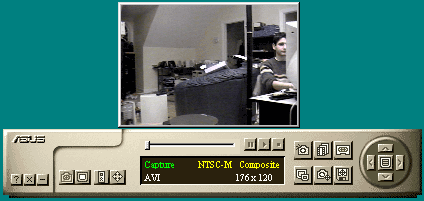 software
that allows for MPEG-II software capture. The ASUS Live software program can
capture video still shots in BMP format and can capture video in only AVI format,
creating somewhat of a space hog, hence the need for Video Studio 3.0. We tested
the proprietary ASUS Live software to get a grasp on what the card can do. The
easy to use program includes options for the average resolutions that most video
input cards can capture at: from 320x240 to 704x480. These resolutions provided
sufficient capture options, whether you wish to send an online video or make
a full motion movie. Upon first glance, the images inputted using our S-Video
from JVC Digital Video camera looked better than the Voodoo 3500 TV which often
suffered from poor colors, slight flickering and lower capture resolutions.
The video capture part of the card is able to capture at up to 30 FPS, qualifying
it as D1 resolution (full NTSC or full PAL resolution). The bundled ASUS Live
software allows you to change the frame rate which you capture at from 30 FPS
to lower preset values, saving valuable disk space when high FPS ratings are
not required. Another nice feature of the ASUS Live software working with the
V6600 Deluxe is the fact that it can capture at almost any resolution without
significant frame rate loss. Even at 704x480 with lots of motion, the number
of frames dropped on a 30 FPS capture turned out to be less than significant.
software
that allows for MPEG-II software capture. The ASUS Live software program can
capture video still shots in BMP format and can capture video in only AVI format,
creating somewhat of a space hog, hence the need for Video Studio 3.0. We tested
the proprietary ASUS Live software to get a grasp on what the card can do. The
easy to use program includes options for the average resolutions that most video
input cards can capture at: from 320x240 to 704x480. These resolutions provided
sufficient capture options, whether you wish to send an online video or make
a full motion movie. Upon first glance, the images inputted using our S-Video
from JVC Digital Video camera looked better than the Voodoo 3500 TV which often
suffered from poor colors, slight flickering and lower capture resolutions.
The video capture part of the card is able to capture at up to 30 FPS, qualifying
it as D1 resolution (full NTSC or full PAL resolution). The bundled ASUS Live
software allows you to change the frame rate which you capture at from 30 FPS
to lower preset values, saving valuable disk space when high FPS ratings are
not required. Another nice feature of the ASUS Live software working with the
V6600 Deluxe is the fact that it can capture at almost any resolution without
significant frame rate loss. Even at 704x480 with lots of motion, the number
of frames dropped on a 30 FPS capture turned out to be less than significant.
The real problem with the capture function for the V6600 Deluxe is not seen until a screen shot is taken or a movie is closely examined. Running at any resolution, 320x240 all the way to 704x480, lines were visible due to interlacing. Interlacing is a feature that is found in most non-computer video devices. Interlacing allows a device to draw only half the horizontal lines with each pass of the device's electron gun. Because an interlaced device refreshes only half the lines at one time, it can display twice as many lines per refresh cycle. While this feature provides clear pictures on a television, computer devices are non-interlaced to allow for faster reaction time. The V6600 Deluxe takes in these interlaced signals and then attempts to de-interlace them. In the Philips chip used in the card, this de-interlacing results in a sandwiched view of the frames: each frame contains two interlaced frames. The final product of this feature leaves much to be desired, as the resulting picture or video has mismatched horizontal lines when motion is present on the screen. While the average user will not see the lines when displayed back on a television, the lines are present and cannot be missed upon close examination of the AVI file or the captured bitmap file.
While this may seem like a significant downside to such a great card, keep in mind what ASUS is attempting to accomplish the V6600 Deluxe. Rather than target a select group with great video capture functions at a high price, ASUS chose to make a card and include a software bundle that is more of an additional feature to a great gaming card. This card is not meant for the professional video editor, rather ASUS added such features to entice more of the high end market and give hard-core gamers an additional toy to play with. This toying can include placing and editing home videos on the computer or sending videos online. The feature, however, is not to be used to edit with professional quality.
We have noticed that most of the GeForce based cards that we have seen are not as eagerly overclocked as NVIDIA's previous generation of processors, the TNT2. One would suspect that the reduced die manufacturer of the processor (.22 micron) would result in a greater overclocking potential because, as a rule of thumb, smaller means cooler and cooler means more overclocking potential. The GeForce processor does not react in the way predicted mainly due to the increased number of transistors that are found on the chip. Increasing the transistor count results in additional heat, thus the amount of heat lost by reducing the chip architecture is made up for by the increased transistor count.
While the V6600 Deluxe comes shipped with the NVIDIA's suggested core speed, this was not originally the plan. When the V6600 Deluxe was first produced, it featured a blazing 150 MHz core and 195 MHz stock speed and the plan was to ship it that way. It was not until NVIDIA requested the change be made that ASUS lowered the clock speeds down to the suggested speeds. Knowing this fact, we wanted to see how much we could push out of the card. The other GeForce cards that we have seen have been able to reach a maximum processor speed of about 150 MHz, so we suspected that the V6600 Deluxe would be able to reach this apparent plateau as well. We were very pleased to find that the precisely applied thermal grease and high quality fan allowed us to clock the processor at the unheard of speed of 158 MHz, resulting in the fastest GeForce processor clock speed seen yet.
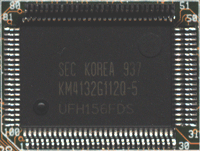 Unlike
the processor speed limit found in most other cards, the memory clock seeds
in GeForce based cards are mainly dependent on the speed of the RAM used. Until
now, the other cards we have seen came with 5.5 Ns SDRAM modules. The ASUS V6600
Deluxe, on the other hand, comes with speedy 5 Ns SGRAM chips. The 5 Ns rating
translates in a maximum speed of 200 MHz, well over the stock speed of 166 MHz.
As was the case with the core speed, the original ASUS plan had the SGRAM chips
running at 195 MHz and it was only changed at the request of NVIDIA. Even with
a speed rating of 200 MHz, we were pleasantly surprised to find that when overclocked,
the memory would push up to 208 MHz. This is quite impressive, considering the
fact that the GeForce processor is very picky with memory due to its quick level
of memory saturation.
Unlike
the processor speed limit found in most other cards, the memory clock seeds
in GeForce based cards are mainly dependent on the speed of the RAM used. Until
now, the other cards we have seen came with 5.5 Ns SDRAM modules. The ASUS V6600
Deluxe, on the other hand, comes with speedy 5 Ns SGRAM chips. The 5 Ns rating
translates in a maximum speed of 200 MHz, well over the stock speed of 166 MHz.
As was the case with the core speed, the original ASUS plan had the SGRAM chips
running at 195 MHz and it was only changed at the request of NVIDIA. Even with
a speed rating of 200 MHz, we were pleasantly surprised to find that when overclocked,
the memory would push up to 208 MHz. This is quite impressive, considering the
fact that the GeForce processor is very picky with memory due to its quick level
of memory saturation.
The resulting overclocked card runs at a fast 158 MHz core speed and a 208 MHz memory speed. Stability was not an issue at these speeds, as the card performed a looped 3D test for 24 hours. When overclocked, we held a card that produced the fastest FPS ratings seen yet in any SDR cards.
Rather than repackage the reference drivers provided by NVIDIA, ASUS chose to make drivers of their own, a decision which proved to be a wise one. The taskbar resident driver bar allowed for quick access to the majority of the settings available with the card. In addition to the normal D3D and OpenGL settings that are included with most higher end cards these days, the V6600 Deluxe also features driver tabs for D3D VR and OpenGL VR. Using the settings found here, the VR features of any game can be tweaked to near perfection. Color adjustments are also available for not only the desktop but also for D3D and OpenGL games. Television input color can also be controlled using the included driver set.
One of the best driver feature of the V6600 Deluxe is the packaged Smart Doctor software. This software takes the information sent to it by the Winbond W8371D chip and displays it very intuitively on the screen. Easily seen in graph type views, the current fan RPM, core temperature, and core voltage are displayed. In addition to these features of the Smart Doctor software, it also includes some very cool overclocking functions. The card features what ASUS calls dynamic overclocking. What this feature does is change the clock speed when needed. For example, when in Windows the clock speed jumps down to a comparatively slow 86 MHz core speed and 82 MHz memory speed. These speeds are adjusted to higher levels when the video card is taxed, for example in any 3D games or programs. Also included is an overheat protection feature that prevents the chip from being clocked too high. If the internal temperature sensor reads that the chip is too hot, the dynamic clock function steps in and clocks down the card, resulting in a lower running temperature.
The one complaint we have with the Smart Doctor software is that it constantly switches focus to the program if a problem is detected. While this may make sense intuitively, problems can be run into if, for example, your motherboard does not put out exactly the correct voltage. You may not notice the problem but Smart Doctor will, and it will continue to notify you by switching focus to the program. This feature, in Quake III Arena, results in a white box flashing on the screen every 5 seconds (or for the time interval you have the monitoring at) and disappearing. In programs where focus can be switched (a feature which Quake III has left out), the game will minimize and Smart Doctor will appear. Quite annoying if you know of the problem and know that it is not really an issue.

The taskbar allowed us to
change settings at a the click of a mouse.
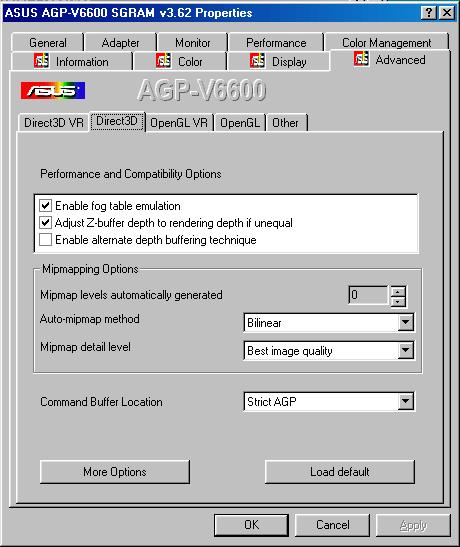
D3D settings were easy to
find and tweak.

OpenGL settings could be modified easily as well.

The D3D VR settings are essential for having a proper VR setup.
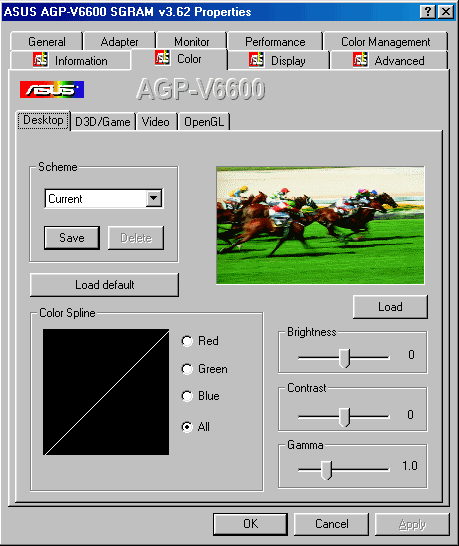
The desktop color tweaking utility.
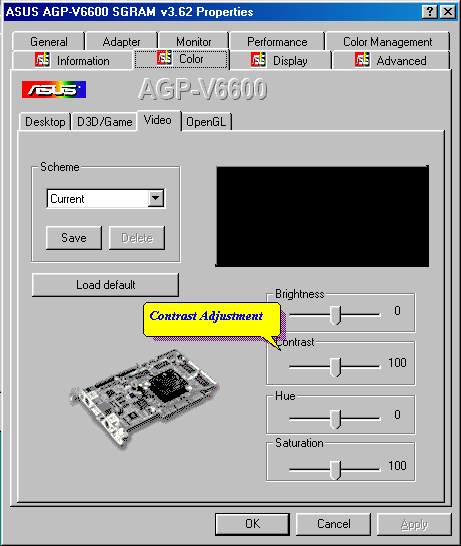
Proving a color adjustment
is key for proper video output.

The Smart Doctor utility can be very useful for proper monitoring of the card.
Please note that the card tested here was clocked down from the 150/195 rating it came shipped to us with, to the new default speed of 120/166.
|
|
Windows
98 SE Test System
|
|
|
Hardware
|
|
CPU(s) |
Intel Pentium III 550E |
| Motherboard(s) |
ABIT
BF6
|
| Memory |
128MB PC133 Crucial Technology SDRAM |
| Hard Drive |
Quantum Fireball CR 8.4 GB UDMA 33 |
| CDROM |
Acer 24x |
| Video Card(s) |
ASUS V6600 Deluxe |
|
|
Software
|
|
Operating System |
Windows 98 SE |
| Video Drivers |
|
|
|
Benchmarking Applications
|
| Gaming |
GT
Interactive Unreal Tournament 4.04 UTbench.dem |
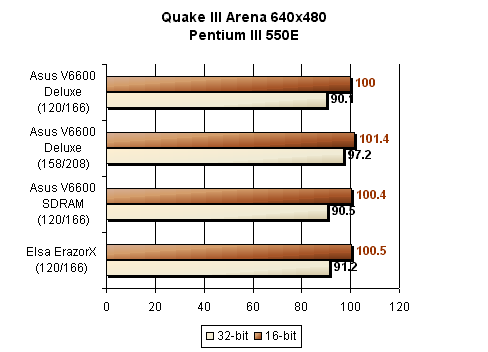
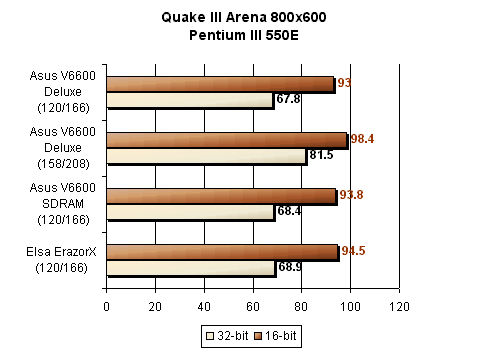
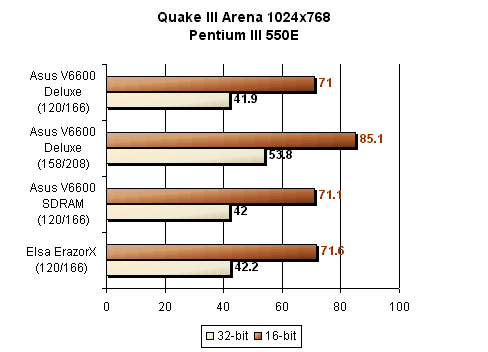
As can be seen by the benchmark graphs, the ASUS V6600 Deluxe on par with the other SDR GeForce card reviewed so far. When pushed even further by overclocking, the Deluxe comes in with blazing speed not yet seen in any other GeForce SDR card. Notice that the difference in speed starts smaller and gets larger with larger resolutions and addition colors. This is due to the fact that at lower resolutions and colors, the GeForce is already going faster than the game can put at it. With more colors and higher resolutions, the overclocked memory and core speeds make a large difference.
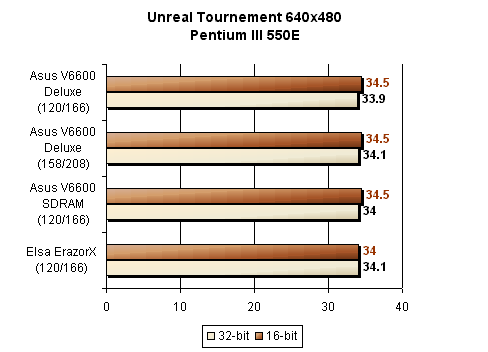
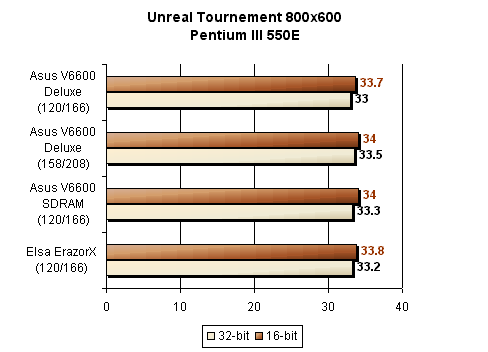
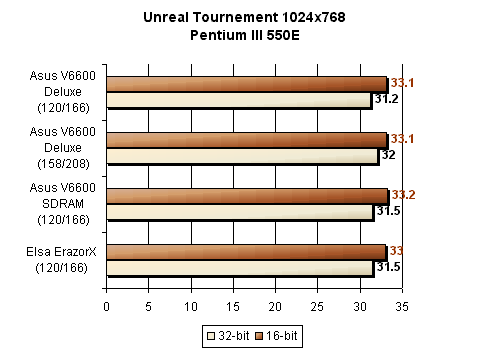
As noticed in most video card reviews, the core and memory speeds of GeForce based cards do not result in a significant difference in FPS rates. This is most likely due to the fact that the new GeForce cards are already drawing faster than the Unreal engine can take advantage of. Notice the almost identical speeds between the normally clocked Deluxe and the overclocked Deluxe.
ASUS has always produced quality products and the V6600 Deluxe is no exception. Unlike the reference based SDR boards that we have seen, the Deluxe's proprietary design results in a card that is exceptional in many ways. S-Video, composite and VR features all make this card a very strong buy, but they also effect the price. The Deluxe runs about $50 more than its Pure brother. Is the increase in price worth the additional features?
First is the S-Video out and composite out features of the card, driven by the Chrontel 7005 chip. The Chrontel chip, when paired to the ASUS V6600 Deluxe, provides a very nice addition to the card. Not only can you play your favorite games on that new 32" television you got for your birthday, but you can also display your computer display to a verity of different output devices via the composite and S-Video connectors and included cables.
The next feature that sets the Deluxe apart from the competition is the S-Video in feature, driven by the Philips SAA7113A video input processor. While we always find video in features of a card to be a nice addition, the true picture quality of the input varies from card to card. While the input from the V6600 Deluxe is not as clear as that from the Matrox G400 TV, it does provide good midrange video input performance. You could use the video input connector to do anything from burning your home videos to a CD to recording and sending an online video.
The final hardware feature that sets the V6600 Deluxe apart from other GeForce based cards is its included VR features. These glasses provide a unique gaming experience that can not be had any other way, but unique is not always better. Once the novelty attraction of the VR glasses wear off, the not so stylish glasses will most likely find their way into a desk drawer to prevent others from knowing that you have them. The VR effect provides more of a first time excitement than a long term thrill.
As far as software goes, the drives included with the V6600 Deluxe are very good for the average user. While they lack some of the advanced features found in the ELSA driver set, the included features are easy to use and navigate. Also included in the package is ASUS's software driven DVD decoder, a nice piece of software that allows you to watch DVD movies right on your desktop. This software is great for those who have a computer DVD player and want to watch a movie on their television. By simply hooking up the S-Video cables and pressing play, the DVD video can now be watched on a full size screen as opposed to the computer monitor. The boxed package also includes 2 full feature games (Darkan and Rollcage) and additional game demos, all of which are mostly useless to the avid gamer. In addition to all the 3D functions, the V6600 Deluxe provides clear and crisp 2D images at resolutions as high as 1600x1200.
When all is considered, ASUS has created a powerhouse of a card with the V6600 Deluxe. Is the increase in price worth the increase in performance and features? You bet! First, the card performs on par than any other GeForce card we have seen. In addition, the overclocked speeds of 158/208 MHz leave even the most hard-core gamer satisfied. With good DDR GeForce based cards out there now running about the same price as the $270 V6600 Deluxe, why would one opt for this card? The answer is simple: anyone who wants extreme speed and would also like video options. This card makes most sense for someone who just got a new video camcorder or other S-Video based device and would like to toy with video editing while still having a very strong gaming card. Video features aside, the ASUS V6600 Deluxe, with its highly overclockable memory and clock speeds, obtains the status of SDR GeForce card to beat: a challenge for both the consumers and the manufacturers.

